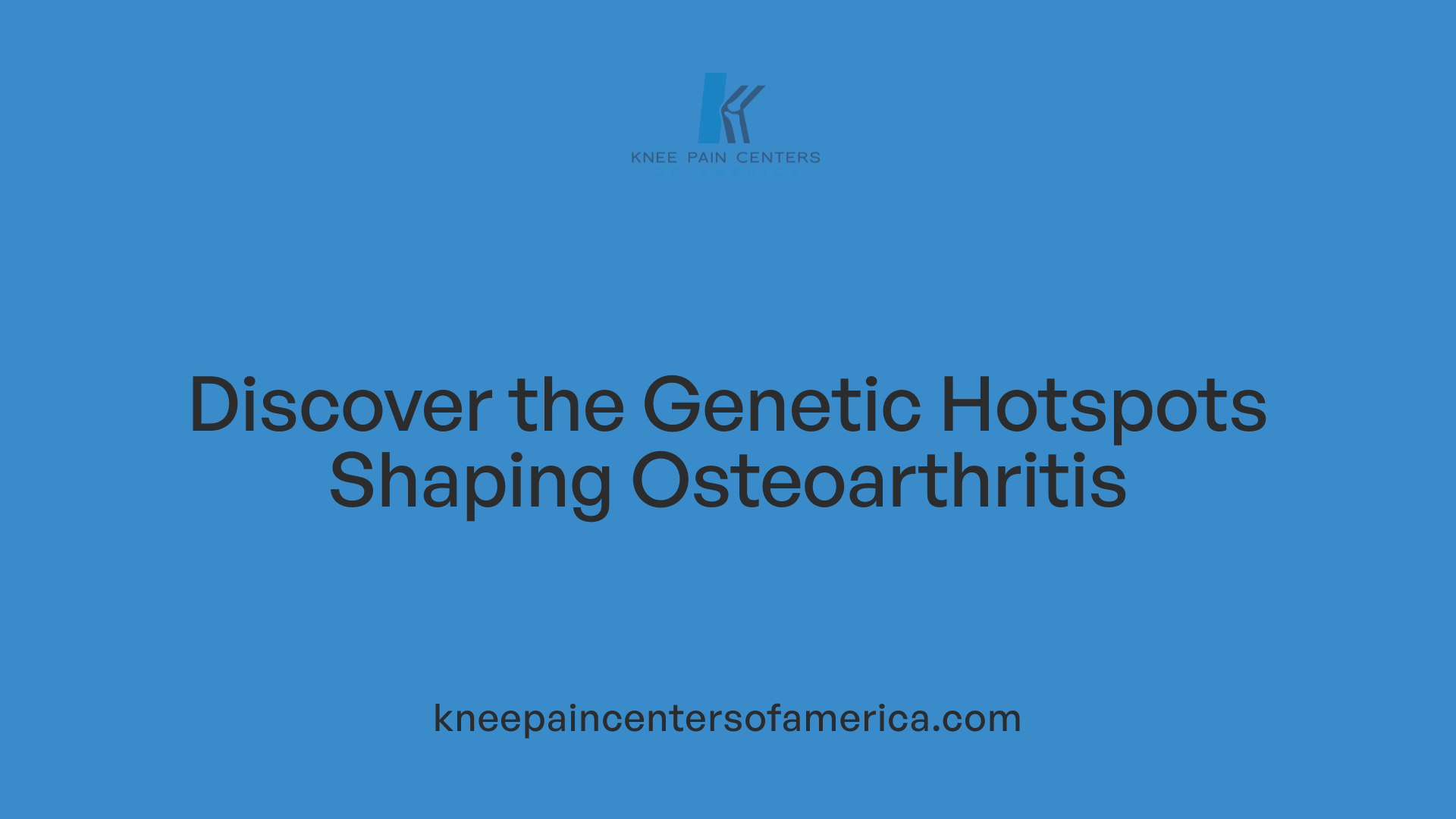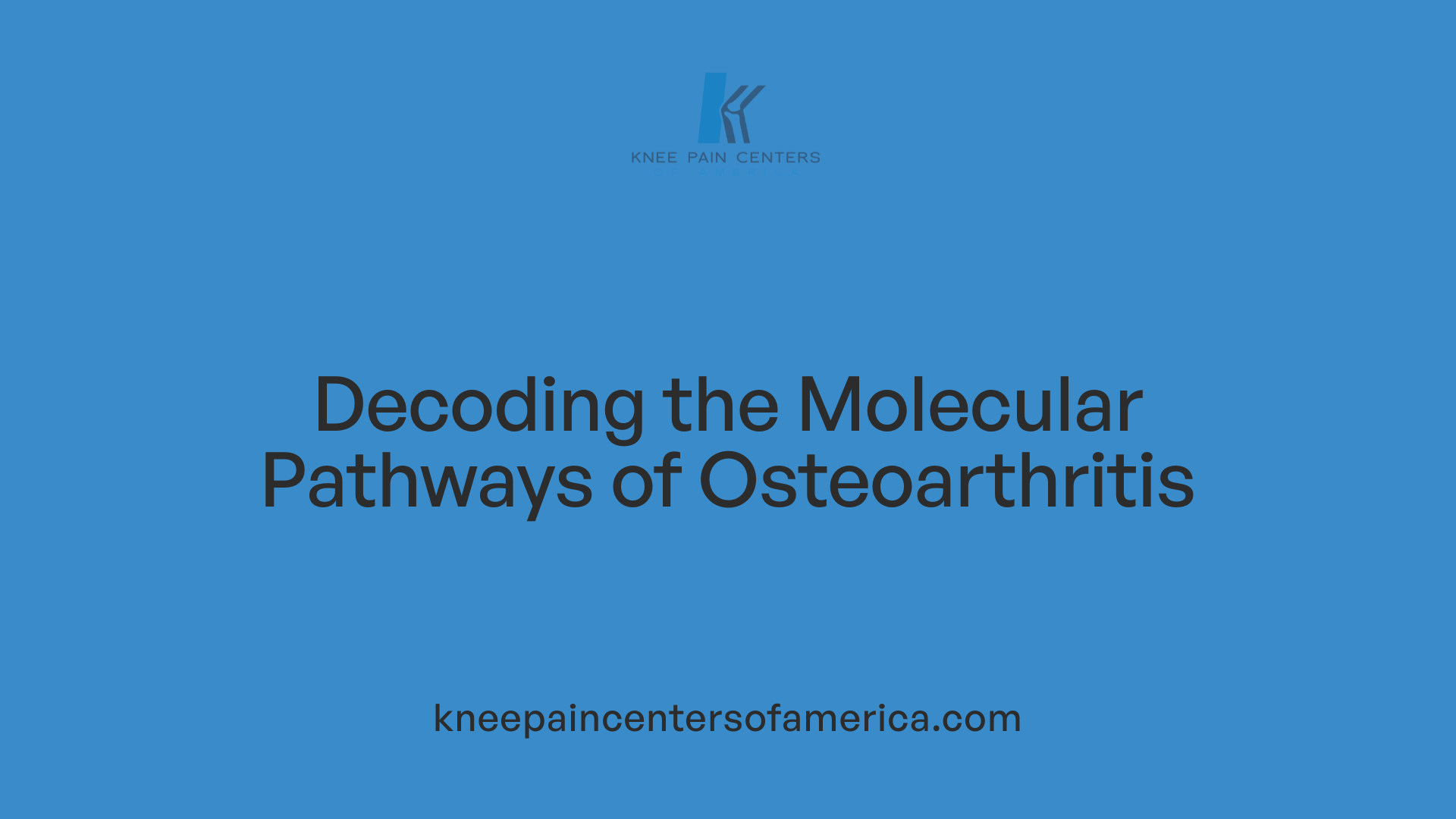Understanding the Genetic Foundations of Osteoarthritis
Osteoarthritis (OA) is a complex degenerative joint disease affecting millions worldwide. While environmental factors such as age, obesity, and joint injuries are well-recognized contributors, mounting evidence underscores the substantial role genetics play in disease susceptibility, progression, and severity. This article delves into the multifaceted genetic underpinnings of OA, exploring heritability estimates, key susceptibility loci, gene variants, and recent advances in genetic research that are shaping future therapeutic strategies.
Genetic Influence on Osteoarthritis: An Overview

How significant is the role of genetics in osteoarthritis compared to environmental factors?
Genetics play a crucial part in the development of osteoarthritis (OA), with heritability estimates for different joints varying from approximately 35% to 65%. For instance, heritability is highest in the spine (around 70%) and the hand (up to 86-87%), and somewhat lower in the hip (48-66%) and knee (around 40%). These figures are supported by family and twin studies conducted since the 1940s, which consistently demonstrate that genetic factors strongly contribute to OA risk.
Family studies have shown that conditions such as Heberden and Bouchard nodules tend to cluster within families, indicating genetic predispositions. Twin studies further reinforce this, especially for hand and hip OA, confirming a substantial genetic component.
Unlike straightforward Mendelian inheritance, osteoarthritis involves a complex pattern of multiple gene interactions, known as polygenic inheritance. Over 300 genomic loci and more than 124 single nucleotide polymorphisms (SNPs) across various chromosomes have been identified as associated with OA. Many of these variants are located in non-coding regions, likely influencing gene regulation rather than direct protein changes.
Genes involved in cartilage structure, such as COL2A1, COL11A1, and COL9A3, influence cartilage integrity, while those related to inflammation, like cytokine genes (IL-1, IL-6, IL-17), also contribute to susceptibility. Variants affecting cartilage repair, bone density, and immune responses all play a role.
Furthermore, genetic effects often modify the disease process rather than its initiation. For example, variants in genes like GDF5 and FRZB are linked to early joint development and later degeneration. Mitochondrial DNA haplogroups also impact OA severity and risk.
Despite the significant genetic influence, environmental factors are equally important. Factors such as obesity, joint injury, physical activity, gender, and occupation significantly influence OA development. These environmental elements often interact with genetic predispositions, amplifying or mitigating the risk.
In summary, osteoarthritis is the result of a complex interplay between genetic vulnerabilities and environmental exposures. While genetic factors set the stage for susceptibility, lifestyle and environmental factors largely determine if and when cartilage breakdown occurs, highlighting the importance of personalized approaches to prevention and treatment.
Inheritance Patterns and the Genetic Architecture of OA
Is osteoarthritis hereditary, and what are the inheritance patterns?
Osteoarthritis (OA) is influenced by a notable genetic component, although it does not follow simple Mendelian inheritance patterns like some single-gene disorders. Instead, OA is a polygenic disease, meaning that multiple genes interact to affect an individual's risk. Research indicates that genetic factors contribute between 35% and 65% to the variability in disease development and severity.
Family and twin studies have long supported the genetic influence on OA. For example, familial tendencies are observed in the occurrence of Heberden and Bouchard nodules, common signs in hand OA. Twin studies reveal heritability estimates of around 50% or higher for various joints, especially the hand, hip, and spine.
Numerous genes have been identified that influence OA risk. Variations in genes encoding structural cartilage proteins like COL2A1 and COL11A1 are associated with early-onset disease and severity. Genes involved in inflammation, such as interleukins IL-1, IL-6, and IL-17, also seem to modulate susceptibility.
Additionally, genes affecting cartilage matrix composition, remodeling, and signaling pathways — including VDR, FRZB, IGF-1, and TGFβ1 — play roles in disease development. Variants in mitochondrial DNA haplogroups, such as J and U, further influence OA susceptibility and severity.
Genome-wide association studies (GWAS) have identified over 100 polymorphic DNA variants across many loci, most located in non-coding regions that regulate gene expression. For instance, a variant in COMP can dramatically increase OA risk in specific populations, but such effects are often modest and context-dependent.
Overall, OA's inheritance pattern is complex, involving multiple small-effect alleles. This polygenic nature supports the liability threshold model, where an accumulation of risk alleles, combined with environmental factors, exceeds a threshold leading to disease manifestation.
In summary, while OA is not directly inherited in a straightforward manner, genetic predisposition significantly influences disease risk. Family and twin studies, along with extensive genetic research, confirm a substantial hereditary component that interacts with lifestyle and environmental factors to shape individual susceptibility.
Key Genes and Loci Associated with Osteoarthritis

What is the role of gene variants and loci in osteoarthritis?
Gene variants and loci are fundamental in understanding osteoarthritis (OA), as they influence an individual's susceptibility to the disease and its progression. Over 300 genomic regions have been identified through large-scale genome-wide association studies (GWAS), revealing a complex, polygenic architecture. Notably, candidate gene studies have linked specific genes like COL11A1, COL2A1, GDF5, and MCF2L to early-onset OA, disease severity, and cartilage repair processes.
Genetic influences are evident across various chromosomes, with susceptibility loci associated with structural components of cartilage and bone, immune response, and tissue remodeling. For example, regions near the HLA genes suggest an immune component, while others involve genes directly regulating cartilage matrix integrity. Variants in COL2A1, coding for type II collagen, play a role in cartilage resilience, and mutations here are linked to inherited cartilage disorders.
Heritability estimates for osteoarthritis vary by joint, with figures reaching up to 87% for hand OA and approximately 60% for hip OA, emphasizing the genetic contribution. These loci and gene variants influence critical biological pathways, including transforming growth factor-beta (TGF-β), Wnt, and bone morphogenic protein (BMP) signaling pathways, which govern skeletal development, extracellular matrix organization, and tissue repair.
Overall, the identification of multiple loci and gene variants highlights the polygenic nature of OA, with each contributing modestly but collectively playing significant roles in disease risk and progression. Understanding these genetic factors offers hope for personalized therapies and better risk assessment in osteoarthritis management.
Genes Implicated in Cartilage and Bone Development

How do gene variants influence the development and progression of osteoarthritis?
Genetic factors greatly impact how osteoarthritis (OA) develops and advances. Recent large-scale genome-wide association studies (GWAS) have uncovered over 100 genetic variants linked to OA, with most found in regions of the genome that do not code for proteins directly. Instead, these regions regulate how genes are expressed, particularly in pathways crucial for maintaining cartilage health and the integrity of the extracellular matrix.
Many of these variants influence genes involved in skeletal morphogenesis, cartilage repair, and tissue development. Notable examples include GDF5, COL2A1, and ASPN. GDF5 encodes a growth differentiation factor vital for cartilage and bone development, while COL2A1 produces collagen type II, a primary component of cartilage tissue. Variations in these genes can affect the structural properties of cartilage, making it more susceptible to wear and tear.
Heritability estimates suggest that genetic influences are more pronounced in certain joints, like the hand and hip, where genetic predispositions are stronger. Variations in these genes may lead to early-onset OA and affect the tissue’s ability to repair itself after injury.
Furthermore, epigenetic modifications such as DNA methylation also modulate gene activity, interacting with genetic variants to influence disease risk. These insights highlight a complex interplay where gene variants can lead to alterations in tissue development, repair processes, and cartilage resilience.
Understanding the roles of these genes opens pathways for new therapeutic strategies aimed at modifying disease course or preventing early tissue degeneration in susceptible individuals.
| Gene | Role in Tissue Development | Impact of Variants | References / Notes |
|---|---|---|---|
| GDF5 | Skeletal morphogenesis, joint formation | Variants associated with early OA | Crucial for cartilage growth |
| COL2A1 | Cartilage matrix formation | Variants linked to cartilage deterioration | Major collagen in cartilage |
| ASPN | Tendon and ligament formation | Variants increase OA risk | Influence tissue resilience |
| DIO2 | Chondrocyte differentiation | Variations affect cartilage health | Regulates thyroid hormone in tissues |
More research into these and other genes, along with their regulatory mechanisms, will deepen the understanding of OA pathogenesis. This knowledge aims to lead to targeted interventions that can slow or halt disease progression, ultimately paving the way for personalized osteoarthritis treatments.
The Significance of Genetic Pathways and Biological Processes in OA

What role do gene variants and loci play in osteoarthritis?
Gene variants and loci are fundamental in shaping an individual's risk of developing osteoarthritis (OA). Over the years, more than 300 genomic regions have been linked to OA through large-scale studies like GWAS. These regions often contain genes involved in cartilage and bone formation, such as COL2A1 and GDF5, which influence how cartilage develops, repairs, and maintains its structure.
Certain gene loci, particularly those associated with immune regulation like the HLA region, suggest that immune system pathways also contribute to OA's pathology. Heritability estimates for OA are notably high, especially for hand and hip joints, underscoring the importance of genetics.
Most risk variants exert modest effects individually but collectively contribute to disease susceptibility via multiple biological pathways. These pathways include skeletal development, extracellular matrix (ECM) organization, and signal transduction processes, which are critical for joint health.
Overall, understanding how gene loci influence susceptibility through various pathways helps illuminate the complex genetic architecture of OA and opens opportunities for targeted interventions.
How do genetic variations influence signaling pathways like TGF-β, Wnt, and BMP in OA?
Genetic variations can modify the activity and regulation of key signaling pathways that are vital for cartilage health and skeletal development. The TGF-β, Wnt, and BMP pathways, in particular, are heavily implicated in OA progression.
Variants in genes such as GDF5 (a member of the BMP family) and other related genes can alter their expression or function. For instance, changes in GDF5 gene expression may impair cartilage repair and regeneration, increasing OA risk.
Similarly, variations affecting transcription factors or pathway regulators can disrupt normal signaling. This disruption leads to abnormal chondrocyte behavior—such as dedifferentiation into hypertrophic states—and compromised ECM production. The result is weakened cartilage structure that predisposes joints to degeneration.
GWAS findings reinforce the importance of these pathways, as alterations within them are linked to a heightened risk of osteoarthritis. Recognizing these genetic influences provides valuable insights into potential therapeutic targets, where modulating pathway activity could slow or prevent disease progression.
In conclusion, genetic variations play a critical role in regulating signaling pathways that maintain cartilage integrity and joint health, highlighting their importance in understanding and treating OA.
Epigenetics, Evolution, and Future Directions in OA Genetics

Are there genetic factors that influence the development and progression of osteoarthritis?
Yes, genetics significantly impact the risk and course of osteoarthritis (OA). Large-scale genome-wide association studies (GWAS) have uncovered over 100 variants linked to OA, mostly in non-protein coding regions that regulate gene activity. These regions influence pathways crucial for cartilage maintenance, such as the extracellular matrix organization and cell signaling pathways like TGF-β, Wnt, and BMP.
Heritability estimates for OA differ by joint type, with the highest in hand OA (up to 87%) and somewhat lower in knee and hip OA. Genes such as GDF5, COL2A1, ASPN, and others have been repeatedly associated with susceptibility and severity. Furthermore, genetic influences often interact with epigenetic mechanisms, including DNA methylation and microRNAs (miRNAs), which modulate gene expression in cartilage tissues. These genetic and epigenetic factors combine to shape individual risk profiles, offering insights into disease mechanisms and potential targets for intervention.
What future research directions and potential therapeutic implications are suggested by current genetic studies?
Genetic research in OA is advancing rapidly, promising to revolutionize treatment strategies. Future work aims to include more genetically diverse populations to discover additional variants and understand their functional roles. Emerging techniques, like CRISPR-Cas9 genome editing, enable precise manipulation of candidate genes, helping validate their involvement in OA pathways.
Understanding how genetic variants influence gene regulation, especially through mechanisms like DNA methylation and miRNA activity, can lead to new therapeutic targets. Some existing drugs might be repurposed by targeting proteins encoded by these risk genes, such as those involved in cartilage repair and inflammation.
In the long term, integrating genetic information with clinical data could facilitate personalized treatment plans, early detection, and preventive strategies for OA. This approach holds promise for developing disease-modifying drugs that address the underlying genetic and molecular causes, thereby improving outcomes and reducing disease burden.
Harnessing Genetic Insights for Better Osteoarthritis Management
The expanding landscape of osteoarthritis genetics offers promising avenues for understanding the disease's molecular basis and developing targeted therapies. Large-scale GWAS and functional studies have identified key genes, loci, and pathways involved in cartilage integrity, extracellular matrix organization, and inflammatory processes. These discoveries not only deepen our comprehension of disease mechanisms but also hold potential for personalized medicine approaches and drug repurposing. As research continues to integrate genetic, epigenetic, and environmental data, future strategies will likely focus on early risk assessment, intervention, and tailored treatments, ultimately improving outcomes for individuals affected by osteoarthritis and transforming clinical management.
References
- Genetics in Osteoarthritis - PMC
- Genetics of osteoarthritis - ScienceDirect.com
- Osteoarthritis: MedlinePlus Genetics
- Genetics of osteoarthritis - ScienceDirect.com
- Genetic contribution to osteoarthritis development - PubMed
- Age-dependent genetic regulation of osteoarthritis: independent ...
- Study Unveils 13 Genes That Increase Risk of Osteoarthritis
- Genetics of osteoarthritis: early developmental clues to an old disease
- Osteoarthritis study uncovers hundreds of genetic links & potential ...
- Genetic risk of osteoarthritis operates during human skeletogenesis





